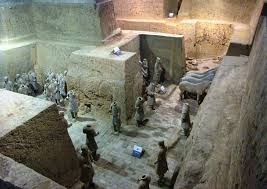
When Will the Mausoleum of Qin Shi Huang Be Excavated?
A Legacy Buried in Time
The Mausoleum of Qin Shi Huang, the first emperor of a unified China, stands as a testament to the ambition and power of the Qin dynasty. Constructed over 39 years, from 247 BC to 208 BC, this monumental tomb complex is a microcosm of the emperor's vision of eternity.
Over 720,000 laborers toiled under the supervision of Li Si, the renowned Qin chancellor, to bring the emperor's vision to life. The sheer scale of the project is staggering. Historical accounts describe a subterranean palace mirroring the emperor's earthly domain, complete with flowing rivers of mercury, a ceiling adorned with celestial constellations, and countless treasures meant to accompany him in the afterlife.
However, the emperor's dream of an everlasting empire crumbled with the Qin dynasty's fall in 206 BC. The unfinished mausoleum was abandoned, its secrets sealed beneath the earth for millennia.
Rediscovering a Hidden Wonder
For centuries, the location and grandeur of the mausoleum lived on in whispers and legends. Then, in 1974, a serendipitous discovery brought the ancient wonder back into the light.
Farmers digging a well near Xi'an, a city steeped in history and known for its numerous ancient tombs, stumbled upon fragments of terracotta. This chance finding unearthed the now-famous Terracotta Army, a vast collection of life-sized terracotta soldiers, horses, and chariots guarding the emperor's tomb.
The Dilemma of Excavation
The discovery of the Terracotta Army sparked international awe and ignited intense curiosity about the secrets hidden within the main tomb. However, excavating the tomb of Qin Shi Huang presents a complex dilemma, one fraught with ethical, logistical, and preservation challenges:
1. Preservation Concerns
The interior of the mausoleum is believed to contain a treasure trove of artifacts, many made from perishable materials like silk, wood, and pigments. Exposure to air and modern conditions could lead to rapid deterioration, potentially destroying invaluable historical relics.
2. Technological Limitations
Historical records describe intricate mechanisms and potentially hazardous materials like mercury within the tomb. Excavating these elements safely and effectively requires advanced technology and expertise that are still under development.
3. Ethical Considerations
The mausoleum is not just an archaeological site; it's the final resting place of an emperor. The decision to excavate must carefully consider the ethical implications of disturbing a burial site of such historical and cultural significance.
Looking Ahead: Balancing Curiosity and Preservation
While the allure of uncovering the secrets of Qin Shi Huang's tomb is undeniable, the focus remains on long-term preservation. Archaeologists and scientists are employing non-invasive techniques like ground-penetrating radar, remote sensing, and digital imaging to map the tomb's interior and analyze its contents without physical excavation.
These methods allow researchers to gain valuable insights into the tomb's structure, layout, and potential contents while ensuring its preservation for future generations.
The question of when, or even if, the main tomb of Qin Shi Huang will be fully excavated remains unanswered. For now, it continues to captivate our imagination, a silent sentinel guarding the mysteries of a bygone era.
Q&A
Q1: Where is the Mausoleum of Qin Shi Huang located?
A1: The mausoleum is located in Lintong District, about 36 kilometers (22 miles) east of Xi'an, Shaanxi province, China.
Q2: What is the significance of the Terracotta Army?
A2: The Terracotta Army, buried near the emperor's tomb, represents the military might that unified China under Qin Shi Huang. It offers unique insights into ancient Chinese military organization, weaponry, and craftsmanship.
Q3: Why is mercury believed to be inside the tomb?
A3: Ancient Chinese texts describe the use of mercury to symbolize rivers and waterways in the afterlife. It is believed that large quantities of mercury were used to create a miniature representation of the emperor's empire within his tomb.